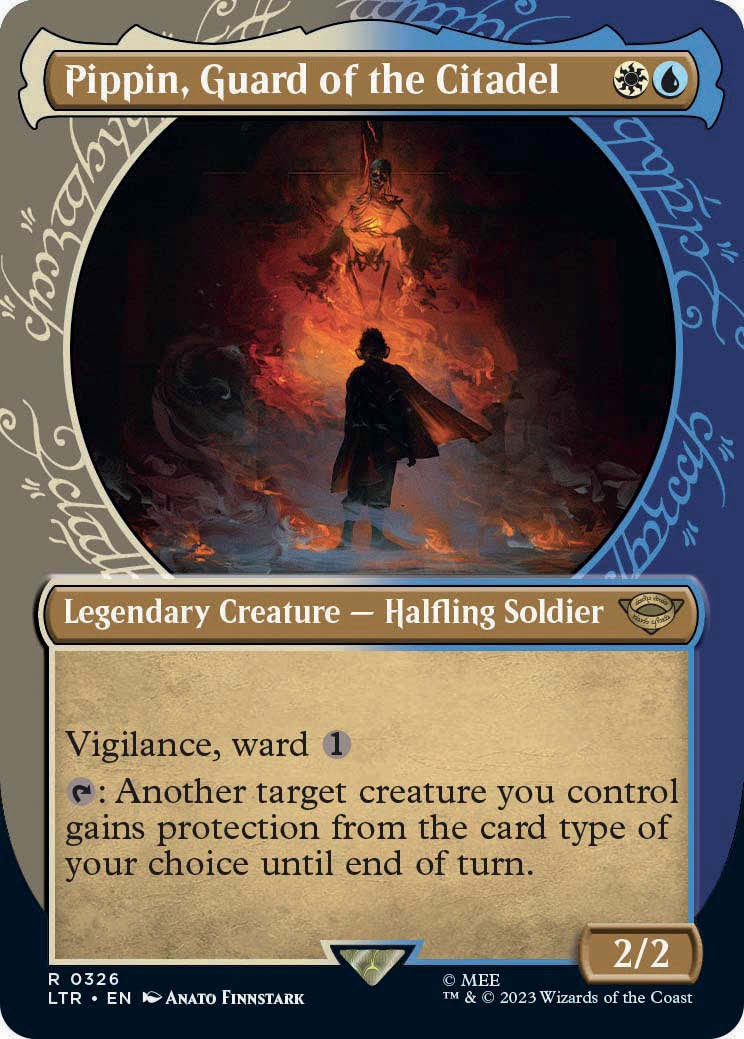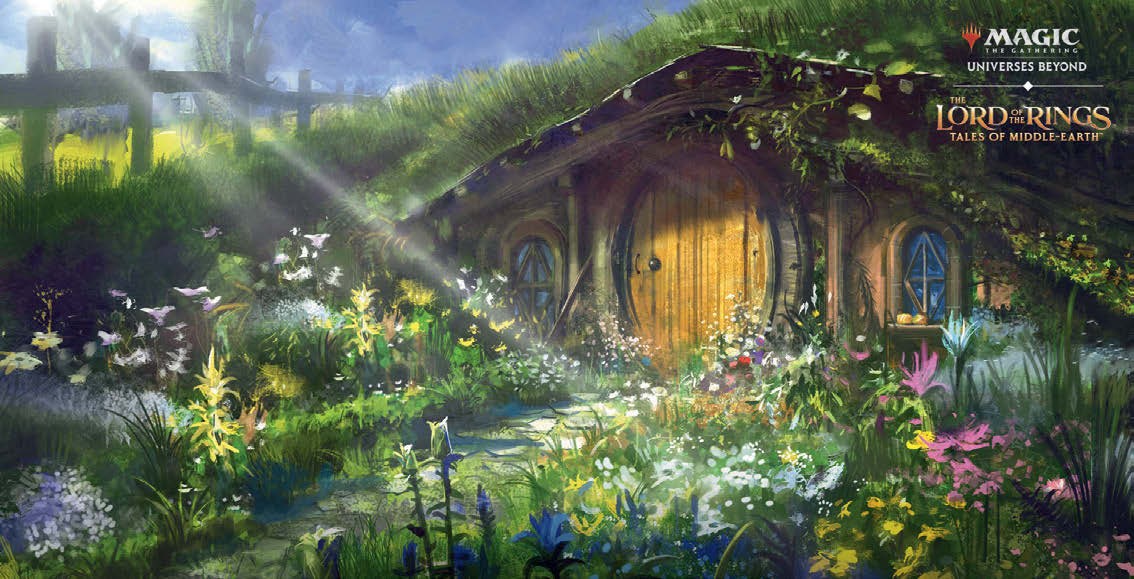There and Back Again | System: Magic: The Gathering
LORD OF THE RINGS: TALES OF MIDDLE EARTH
Designer: Ben Heyes (Lead Designer) | Publisher: Wizards of the Coast
WHAT’S IN THE SET?
◗ 450 Cards with set code LTR
◗ 20 Mythic Rares
◗ 60 Rares
◗ 80 Uncommons
◗ 101 Commons
◗ 20 Basic Lands
◗ 7 Product Restricted Cards
◗ 162 Variant Art Cards
Ever heard of Weiß Schwartz? This Japanese TCG is lauded for its elastic game design, allowing it to feature characters from a wide range of different IPs, with numerous sets for different films, shows and other geeky properties.
I can’t stand it.
Mechanically, the system is fine, a variation of Bushiroad’s other popular TCG Cardfight! Vanguard that’s a little too busy for my personal tastes. But I hate its lack of identity. You can have Goku from Dragonball Kamekameha blast Hatsune Miku whilst Obi-Wan Kenobi watches from the sidelines, just as confused as the rest of us. Maybe I’m just a curmudgeon who can’t enjoy the schoolyard “who would win in a fight?” antics that the game is clearly evoking, but the idea of pushing established IPs through the filter of an already existing system has never sat right with me.
I hope you can now appreciate just how much Lord of the Rings: Tales of Middle Earth had to do in order to successfully impress me.
Universes Beyond has been slowly growing in both popularity and scope since it first appeared back in 2020 (although it wasn’t yet operating under that name), seeking to bring Magic: The Gathering to various properties, so players can have Zangief pilot the Fortnite Battle Bus in the hopes that you can draw Optimus Prime. If I had to simplify my stance, I was worried that this would kill Magic. Not the game system, Magic will continue to be printed long after it stops being entertaining (and I sincerely hope that day never comes.)
But Magic as a world is its own unique curio, a melting pot of fantasy cultural touchstones, with references to gothic horror, Grecian myth, Japanese folklore and so much more, all designed to add their own twists to its predecessors whilst still maintaining a consistent tone between every set.
LTR certainly isn’t a massive leap away from Magic’s tone, as one would expect from the grandfather of fantasy. The visual design lead by Ovidio Cartagena is to be highly applauded (as seen in our Art of LotR in issue 80) for capturing the world of Middle Earth in a way that feels familiar, but still refreshing.
Mechanically, LTR has already had a massive impact on multiple formats. Designing with Modern in mind meant that the team were open to push the boat out on the power level, having to compete in a format already known for its thousand pound plus price tag on decks. Whilst it’s lovely to see the return of food tokens and ‘Amass’ (now used for creating an army of orcs, with backwards compatibility with War of the Spark’s zombie horde) the real ‘temptation’ involves a certain circular jewellery.
Several cards will have you ‘tempted’ by the ring, nominating a creature you control to become your Ringbearer. The ringbearer is now treated as a legendary creature (which in a set with 109 legendary cards, benefits from plenty of ‘legendary matters’ support cards) and gains more and more abilities every time you tempt again, starting with ‘skulk’ (can’t be blocked by more powerful creatures) to looting cards and dealing extra damage on attacks.
If you ringbearer is killed, another creature can pick up the ring and keep all previously unlocked abilities the moment any card says “the ring tempts you,” which can also be used to swap a ringbearer too.
This feature becomes pivotal in limited formats, as the momentum gained by several activations keeps games exciting, finding a fun way to incorporate pursuing the One Ring into gameplay.
Speaking of pursuit, many of you will no doubt be aware of the hunt for the $2 million special ‘One Ring’ card (which some lucky Canadian found a mere week after release), but even at its most common printing ‘The One Ring’ card is proving hard to locate due to heavy demand.
As a 4-mana colourless artefact, this little blighter can slip into literally any deck, giving you protection until the start of your next turn (the perfect momentum cancelling power) and letting you draw cards equal to the number of burden counters on it. Sure, you lose life equal to said counters on your upkeep, but with the Legendary rule letting you wipe the slate clean whenever you need, this card offers one of the most powerful abilities in Magic (drawing cards) with zero colour restriction.
Whilst at least one overpowered and inevitably banned card is sadly common for every Magic Modern set, there’s been surprisingly few other outright dangerous cards, but plenty of interesting highlights. “Delighted Halfing” gives you another turn-1 ramp target that can protect your legendary spells (Hobbit tribal anyone?), “Orcish Bowmasters” lets you not only pick away small threats whenever an opponent draws extra cards, but slowly amass an army worthy of Mordor (this one is particularly lethal in multiplayer formats) and “Spiteful Banditry” seems to be channelling the long dead “Meathook Massacre” with an enchantment that can immediately wipe the board and permanently fuel your Red Deck Wins with treasures for every opposing fatality.

The set overall has done well to find a great balance between referencing Tolkien’s works and providing interesting powers. All of the characters you would expect to find are here across various rarities, so it isn’t just the lucky players opening mythics who get to party with Gandalf and the gang. As a limited CCG player (I rarely get the time for any constructed formats alongside the mountain of games to review each month) I really appreciate the variety of ways the commons capture Middle Earth’s character whilst keeping the gameplay fast and fighty. The cycle of big beasties with landcycling proved highly versatile in draft and sealed, as being able to conjure up a cave troll late game or find that black splash early on is vital for 40-card decks, making it easier to slip in that offcolour legendary rare and have fun with these iconic characters.
LTR has gone hard on immortalising these iconic characters. When there’s three possible Pippin printings, each also available in foil, it’s a collector’s nightmare to try and complete the set. Best of luck to anyone trying to get a full set of the nine different Nazgûl cards; any given card is going for upwards of £8, not bad for an uncommon. There are also several scene cards printings that form different sized murals depicting special events, from the 4-cards showing the finale on Mount Doom to the staggering 18-card scene depicting The Battle of Pelennor Fields. Even people who aren’t fans of the game might want to find these single cards to create a gaming art piece.

And it’s that diversity of interests which will ensure this set is remembered. From its fast-paced limited formats, impactful card releases across various constructed formats and collectable art variants, LTR finds something to entice every TCG player, whether they’re new to Magic or have been playing it these last 30 years. Whilst the concept still makes me uncomfortable for Magic’s narrative future, I cannot deny that this is a fun expansion with plenty to offer new and old Magic players alike.
MATTHEW VERNALL
WE SAY
With a fun limited environment and plenty of iconic characters getting the Magic makeover, it’s an amusing set that might help get new players into the game, whilst still offering great cards for veterans.
TRY THIS IF YOU LIKED UNIVERSES BEYOND: WARHAMMER 40,000...
The first major release in the Universes Beyond line, regardless of what you think about other IP getting the Magic treatment, it’s clear that the design teams know what they’re doing.